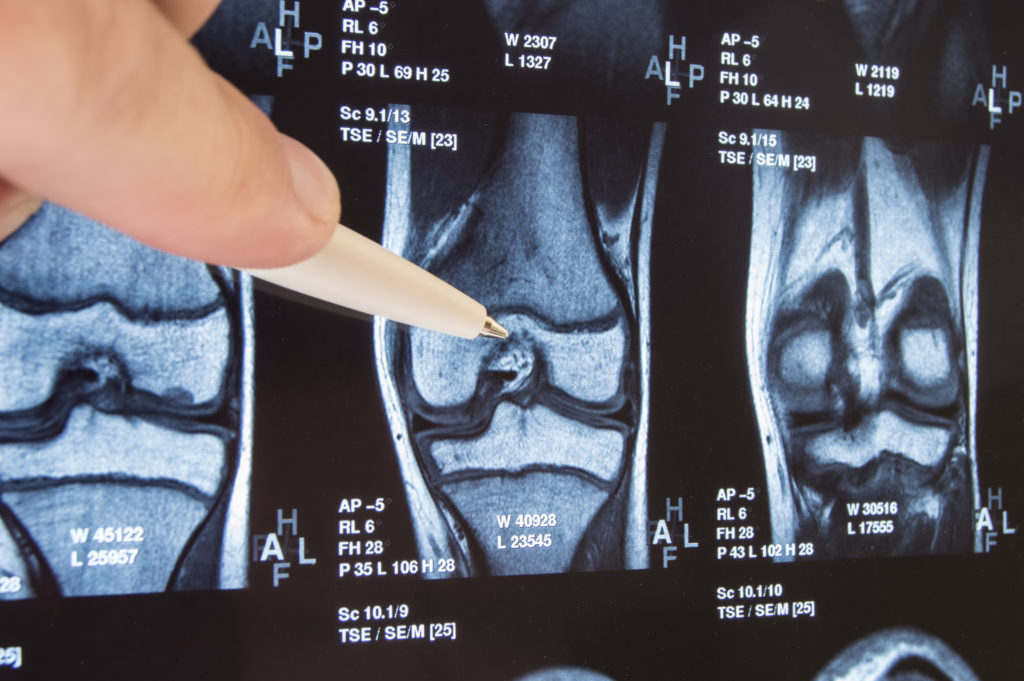THIS POST IS PART OF THE ULTIMATE GUIDE TO SPORTS MEDICINE
Also referred to as torn cartilage in the knee, a meniscus tear is one of the most common knee injuries among athletes; however, anyone can tear their meniscus.
Anatomy
Three bones meet to form your knee joint: your thighbone (femur), shinbone (tibia) and kneecap (patella). Two pieces of cartilage between your thighbone and shinbone act as shock absorbers. These are called meniscus. They are strong, elastic cartilage that helps cushion the joint and keep it stable.
There are many types of meniscus tears. Tears are named by location and shape. Radial, horizontal, vertical, complex and bucket handle are some of the more common types. Sports-related tears often occur in conjunction with other knee injuries, such as ACL or MCL tears.
How do you tear your meniscus?
Sudden tears of the meniscus often occur during sports, but can occur during many activities. When an athlete squats and twists the knee, this can cause a tear. The same moment can also cause a tear during daily activities in any individual.
Older individuals are more likely to have degenerative tears since cartilage weakens and wears thin over time. A simple awkward twist when getting up from a chair may be enough to cause a tear.
Meniscus tear symptoms
- A popping noise when the injury first occurs
- Pain
- Stiffness and swelling
- Locking of the knee
- Inability to move your knee the full range of motion
Physician examination
To determine whether you have torn your meniscus, your physician will ask you for a complete medical history, have you describe your symptoms and how the injury occurred, and conduct a physical examination. An X-ray or MRI may be necessary to confirm the diagnosis and determine if there are other problems.
OrthoIndy is proud to be the official orthopedic provider of the Indiana Pacers. Make an appointment with a knee specialist at OrthoIndy.
How do you treat a meniscus tear?
Treatment depends on the severity of your injury. If your tear is small and does not cause symptoms, surgery may not be necessary.
Nonsurgical options
- Rest
- Ice
- Gentle compression
- Elevation
- Non-steroidal anti-inflammatory medicine
- Physical therapy
Meniscus tear surgery
If you have additional injuries or your symptoms persist with nonsurgical treatment, you may need surgery. Meniscus tear surgery is done arthroscopically using small incisions. This technique is typically done as an outpatient surgery. A meniscectomy involves removing a torn portion of the meniscus, where as a meniscus repair surgery involves stitching the tear back together. The type of tear will dictate whether a repair or partial meniscectomy is done.
How do I recover from meniscus tear surgery?
After surgery, your doctor may put your knee in a brace to keep it from moving. If you have had a meniscus repair procedure, you will need to use crutches for four to six weeks to keep weight off of your knee.
Your physician will prescribe rehabilitation exercises after surgery. Regular exercise to restore your knee mobility and strength is necessary. You will start with exercises to improve your range of motion. Strengthening exercises will gradually be added to your rehabilitation plan.
Many times, rehabilitation can be carried out at home, although your physician may recommend physical therapy. Rehabilitation time for a meniscus repair is about three months. A meniscectomy requires less time for healing, approximately six weeks.
Learn more about having knee pain treated at OrthoIndy.
Schedule an appointment
Your well-being is important to us. Click the button below or call us to schedule an appointment with one of our orthopedic specialists. If your injury or condition is recent, you can walk right into one of our OrthoIndy Urgent Care locations for immediate care. For rehabilitation and physical therapy, no referral is needed to see one of our physical therapists.






